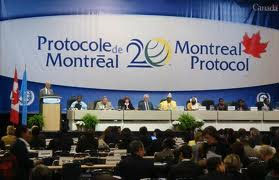30 years ago, a hole in the ozone layer above Antarctica was discovered, and within three years, the world joined to solve the problem under the Montreal Protocol.
But now, all these years later, and with decades of research to back it up, we struggle to get similarly strong action on climate change. Some Republicans in Congress even question that humans can alter the atmosphere.
The ozone hole is a vivid example of how quickly humans can change our atmosphere and how long it takes to heal, Jon Shanklin – one of the scientists who first revealed it – told The Guardian.
It took only about 10 years to develop the ozone hole, but after 30 years it has just begun to recover. It will probably be well into the second half of this century before the CFCs completely dissipate, he says.
And what if we had done nothing? The ozone hole over Antarctica would be 40% larger today and would also be over parts of the Arctic, big enough to affect northern Europe, say scientists at the University of Leeds. UV levels would be about 10% higher in Australia, New Zealand and the UK, causing an even bigger spike in skin cancers.
But we have yet to learn that lesson, Shanklin says. "Then it was chlorofluorocarbons; today it is greenhouse gases" [which hang on in the atmosphere for centuries or more and we are pumping out these gases on a far greater scale].
Once scientists figured out what was causing the ozone hole, CFCs were banned in the most successful international treaty ever.

Addressing greenhouse gases is much, much harder. While repairing the ozone hole was about banning one product – even though it was the main product used for refrigeration – halting carbon emissions cuts to the core of the most powerful industries on Earth.
Montreal Protocol to the Rescue
This week, another Montreal Protocol meeting takes place in Thailand, this time to phase out the successor to CFCs, which turned out to be super-greenhouse gases.
HFCs were developed as a temporary substitute for CFCs until truly clean alternatives could be developed (which are now readily available), and they too need to go. India and China have been holding efforts back, but now it looks like they are on board.
India wants advanced nations to phase them out by 2035, with another 15 years plus financial support for developing countries. China made a similar commitment.
Mostly used in air conditioning, refrigeration and insulating foam production, HFCs are growing fast worldwide. Although they only account for 2% of emissions, that’s expected to double by 2020 and triple by 2030. As greenhouse gases, HFCs are about 10,000 times more potent than carbon dioxide.
As we’ve written about many times – If HFCs and other climate forcers are eliminated quickly (black carbon, methane, ground-level ozone), the rate of global warming would be cut IN HALF, keeping global temperature rise under the dreaded 2°C through the end of the century – and perhaps less than that. And it would slow Arctic ice melt by two-thirds.
Read our articles, Obama Prepares for UN Climate Summit With Actions on HFCs and HFCs Lurking in Your Air Conditioning System?
